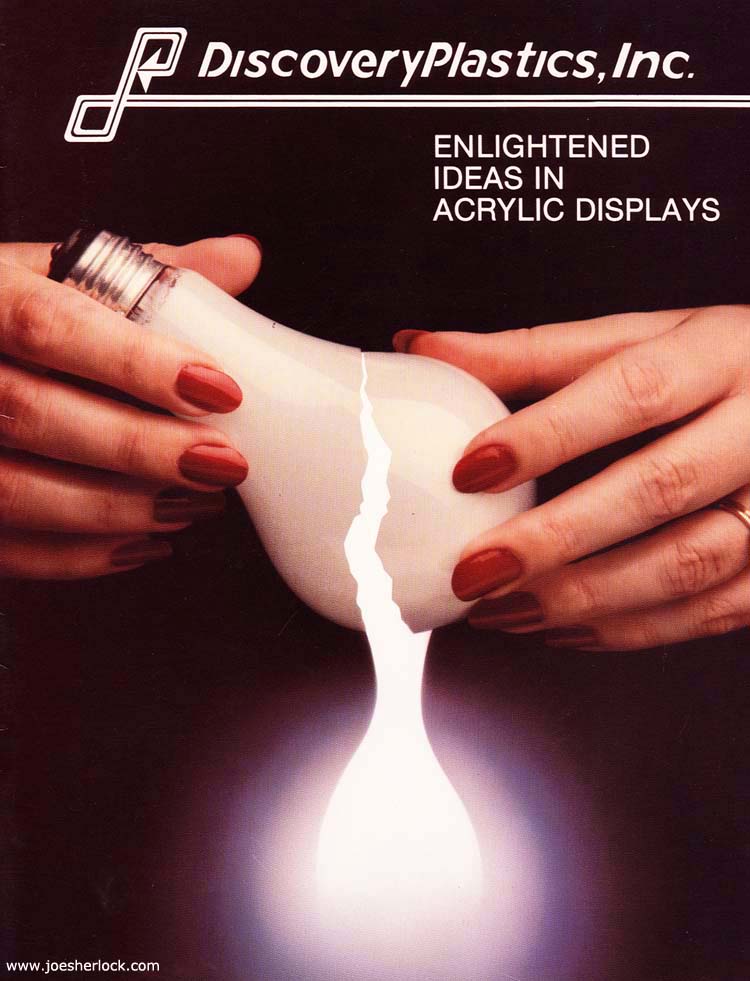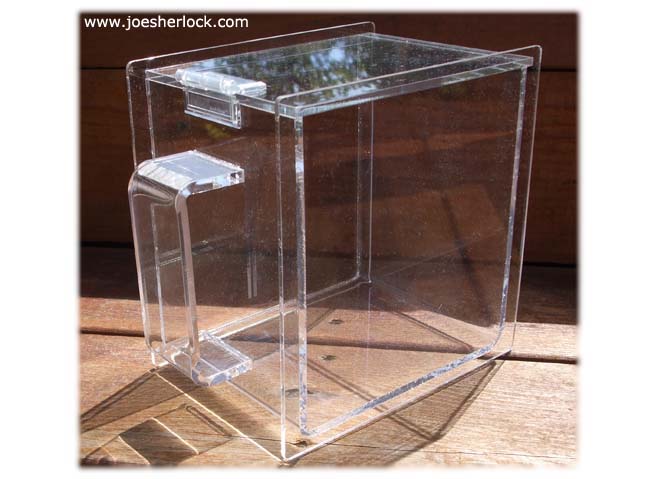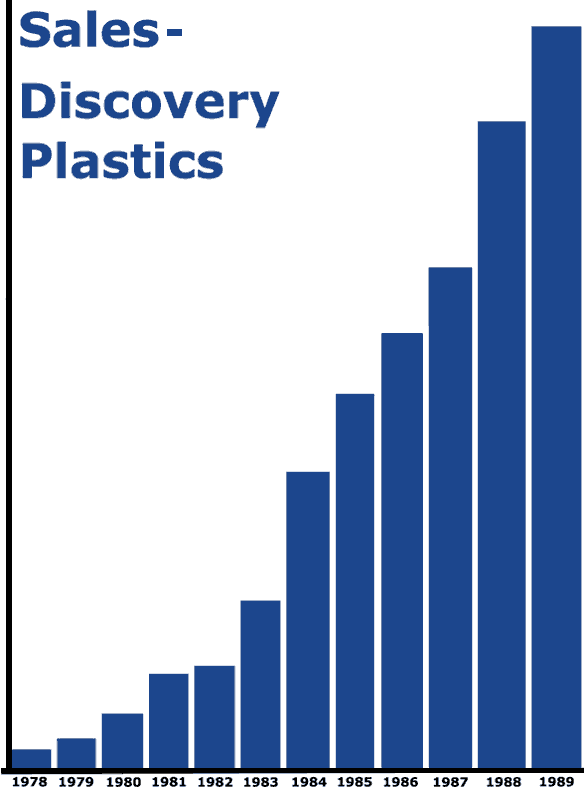|
Discovery Plastics - A History
Part 3: On Display Nationally
As Discovery Plastics grew, the company continued to make inroads into the Plexiglas display market. Around the same time as the initial Hewlett Packard order, Pacific NW Bell (the phone company) awarded DP an order for 13,000 custom point-of-purchase signholder displays.
The following year, HP asked Discovery to design and develop secure countertop displays for its 41C series handheld calculators. The firm came up with designs which utilized bronze-tinted transparent acrylic. Discovery Plastics manufactured these and other Hewlett Packard dealer accessories for several years.
Other large accounts soon followed: White Stag, Jantzen, GranTree Furniture, eb5 Cosmetics, Nail-Magic and more. By 1984, Apple Computer had joined the ranks of Discovery Plastics' top customers.
|
|
|
This custom countertop display for eb5, a cosmetics firm, was designed and manufactured by Discovery Plastics. By getting involved in the design of products, Discovery was able to move away from lower-profit, bid-only business.
|
Eventually, store fixtures and custom displays became the company's largest market segment: 92% of total sales by 1988.
As its ready-made display and store fixture line also grew, Discovery Plastics eventually produced over 525 types of acrylic fixtures (in stock for immediate shipment) published in its annual printed catalog. Sales went national as Discovery sold its products through over 200 store-fixturing distributors across America.
|
|
In 1985, Discovery began to offer acrylic fixtures with brass and chrome accents, as well as glass mirrors and store signage.
|
|
|
Clear Plexiglas shoe displays await inspection at the end of the assembly line.
|
|
|
|
Checking quality on on rotating jewelry displays before they leave the manufacturing area: this stock item used a combination of fabricated and injection-molded plastic components.
|
|
|
One of the largest stock display pieces offered by DP was a full-size Plexiglas foot locker complete with brass fittings and leather handles.
|
In 1986, Discovery Plastics produced its first four-color brochure. Titled 'Enlightened Ideas In Acrylic Displays', the literature showcased the company's design and manufacturing capabilities in the custom display and point-of-purchase field. Sales (and profits) continued to grow at a rapid pace. The 12 page brochure cost only $2,300 to design and print but returned $67,000 worth of net profit from new orders in an 18 month period.

The company also began to design injection-molded components to replace certain fabricated acrylic parts, lowering production costs, improving quality and permitting more design versatility.
Injection-molded shoe displays - produced on molds commissioned by Discovery Plastics and subcontrated to Northwest firms - were economical enough to allow DP to successfully compete against imported Asian-fabricated plastic shoe shelves, keeping jobs in the USA. Other molded subassemblies were used to create new and novel display fixtures, resulting in increased demand and additional employment within the company.
Over the years, Discovery Plastics developed many technical, product and process innovations. The company was the first commercial user of the clear acrylic Acryl-Hinge:

Joe Sherlock designed this square bin with a hinged lid in the mid-1980s to display colorful candies. Six of these were placed inside a custom-fitted rectangular clear acrylic case, which was sited on a retailer's countertop. When a customer wanted to buy some candy, a clerk removed the appropriate box using the handle and opened the lid, pouring the desired amount into a suitable bag or carton. The entire design is water-clear transparent acrylic, including the Acryl-Hinge for the top.
|
The company also used extruded high-impact Plexiglas DR acrylic for all of its slatwall attachment hardware. Discovery was a pioneer in the use of Acrylite FF plastic for display products and was an early adapter of Forrest No-Melt saw blades in its manufacturing operation. Discovery purchased one of the first edge-finishing machines from Edge Finisher Corp. in he mid-1980s. The company also developed a number of unique designs in jewelry displays.
By 1985, Discovery's net profit and ROTA (Return on Total Assets) were solidly in the upper quartile of the plastics fabrication industry. Specifically, by 1985, Discovery Plastics' NPBT (Net Profit Before Taxes) was almost 3 times the median of other plastic distributor/fabricators. In 1984, Discovery Plastics' ROTA was 19.5% - almost 4 times the median of other plastic distributor/fabricators. Discovery's RONA (Return On Net Assets - aka: Return On Investment) was just over 53% for the year.
The company's goal was to increase sales without giving up profit; we targeted a gross profit of 35-40%, which we usually met each year. In 1987, our gross profit was 38.9%. Over an 11-year period, Discovery Plastics' sales had grown at a rate of over 44% per year:

We were able to grow at a fast rate because our quest for high-margin (i.e. - very profitable) work gave us much of the cash flow necessary to underwrite such growth.
|
|
| Loading a trailer with freshly-manufactured, boxed Plexiglas store fixtures on shrink-wrapped pallets in 1985, using Discovery Plastics' ancient 1955 yellow Hyster forklift in Tangent, Oregon. A couple of years later, the company purchased a new forklift and used the ol' Hyster only for back-up.
In '85, two of Discovery's larger display fixture accounts increased their orders by 309% and 71% respectively. By 1987, DP was using one to two truckloads of foam packing peanuts per week just to protect goods during shipment.
|
In late 1989, Discovery Plastics, Inc. was sold to a to RHC/Spacemaster Corporation, a large ($220 million) store fixture conglomerate. In 11 years, DP had grown from a small storefront operation with 3 employees to the largest producer of acrylic store fixtures and displays in North America with over 70 employees.
At their request, Joe Sherlock and John Koegler retained no financial interest in nor managerial control of Discovery Plastics. After the sale was completed, both left the firm to pursue other individual business interests.
During their time running Discovery Plastics, Joe & John met and employed many talented people. Some stayed with the firm. Others moved on to new endeavors. The contributions from exceptional people strengthened the company and made it possible to grow rapidly without losing control of products, processes or Discovery's reputation for high quality and fast customer service.
|
|
|
|
| Periodically, DP distributed a newsletter, 'The Plastics Tribune', to its customers. Each issue carried an 'Ask Mr. Acrylic' column. The inside joke that the bald, mustached, bespeckled Mr. Acrylic was a thinly-disguised caricature of DP's talented, well-liked Distibutor Sales Manager, Dave Kern. |
|
Jenny and Discovery Plastics's other customer service reps were trained to provide smiles, product assistance and courtesy to everyone. |
Several sources have indicated that Discovery Plastics' sales peaked in the late 1990s and, at one point, the division employed over 120. But management problems, market changes and the departure of key executives at the parent company threw a monkey wrench into the smooth-running machine that was once DP.
In early 2003, RHC/Spacemaster Corporation went bankrupt and was soon forced by its creditors into a Chapter 7 liquidation. As a result of the parent company's insolvency, Discovery Plastics closed its doors forever after 30 years of operation. (posted 4/7/12)
| back to: Part 1 - The Beginning |
A message from Joseph M. Sherlock

For a long time, I've wanted to write the history of Discovery Plastics, my first real business venture. I hope you gain some business lessons and insight from reading it. For over 11 years, it took up a huge part of my waking hours. The experience of being an entrepreneur taught me more than I've ever learned sitting in business school or seminar classrooms by a hundredfold.
I'm a big cheerleader for small business ownership. Regular readers of my blog and website know that I'm a fan of small firms in general and would probably enjoy traveling back in time and having a cocktail with George F. Babbitt at a plush hotel bar in downtown Zenith whilst discussing Boosterism. U.S. government statistics show that small businesses accounted for 65% of the 15 million net new jobs created between 1993 and 2009.
That's why I've posted numerous articles on business management on this website. And also why I've posted the stories of remarkable business success stories such as the great Matthias Baldwin who leveraged his precision metalworking skills learned as a jewelry apprentice to create the mighty Baldwin Locomotive Works, which in 1837 - just after the birth of the steam locomotive - employed over 300 people. By 1907, Baldwin was the world's largest locomotive manufacturer and the biggest employer in Philadelphia, with 18,500 workers.
Then there's the inspiring and almost-Runyonesque story of E&T Plastics, founded in 1946 by two refugees from Nazi Germany. Or the tale of tire store magnate Les Schwab. Or retailer Bob Catsiff's marvelous Inland Octupus. I've also posted lessons to be learned from a new business that didn't make it.
In any case, support for small businesses will create local job-growth and, if the business offers products/services which are sold nationwide or worldwide (as Discovery Plastics did), it will bring new dollars into our local communities.
Even George Babbitt knew that's how you create healthy towns. And a healthier America.
After I left Discovery Plastics, I used the knowledge I had gained to assist others. (I was a SCORE volunteer for 24 years, helping mostly young start-up firms.) I also made a very good living as a business consultant, advising established small to mid-size businesses. I retired in 2011.
I believe that, on a personal level, owning your own business will change your life - in a good way:
When you start your own business, you embark on a great journey. You experience times of drama, adventure, fun, fear and pleasure - sometimes all within the same ten-minute period. You make new friends as well.
You don't just learn about business; you learn more about yourself, too. You test your limits and extend your capabilities. And, in my opinion, you become a stronger and better person for doing so. I've seen this happen over and over again with owners of successful, growing businesses of all kinds.
You also taste freedom as you've never known it and you'll never want to be a wage slave for someone else again.
Your own business will take you on an awesome and fulfilling journey - the experience of a lifetime. If you own a business, I hope you are enjoying your Great Journey. I wish you success and prosperity.
|
Other Pages Of Interest
copyright 2012-21 - Joseph M. Sherlock - All applicable rights reserved
Disclaimer
The facts presented on this website are based on my best guesses and my substantially faulty geezer memory. The opinions expressed herein are strictly those of the author and are protected by the U.S. Constitution. Probably.
Spelling, punctuation and syntax errors are cheerfully repaired when I find them; grudgingly fixed when you do.
If I have slandered any brands of automobiles, either expressly or inadvertently, they're most likely crap cars and deserve it. Automobile manufacturers should be aware that they always have the option of trying to change my mind by providing me with vehicles to test drive.
If I have slandered any people or corporations, either expressly or inadvertently, they should buy me strong drinks (and an expensive meal) and try to prove to me that they're not the jerks I've portrayed them to be. If you're buying, I'm willing to listen.
Don't be shy - try a bribe. It might help.
|

